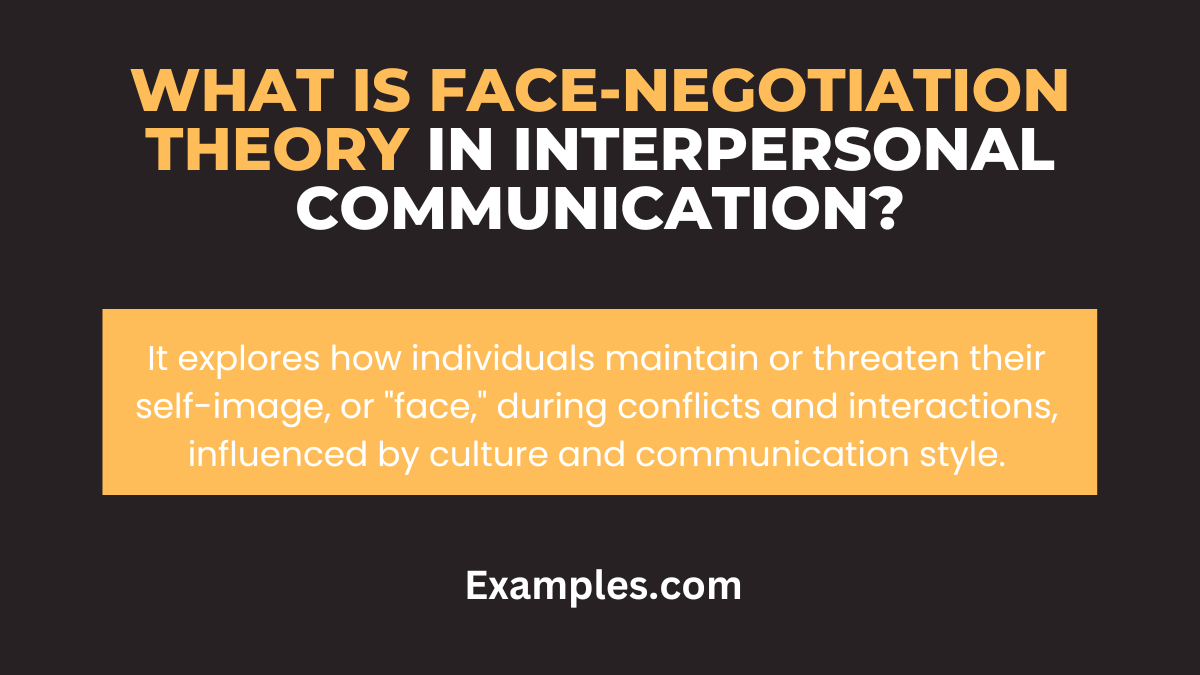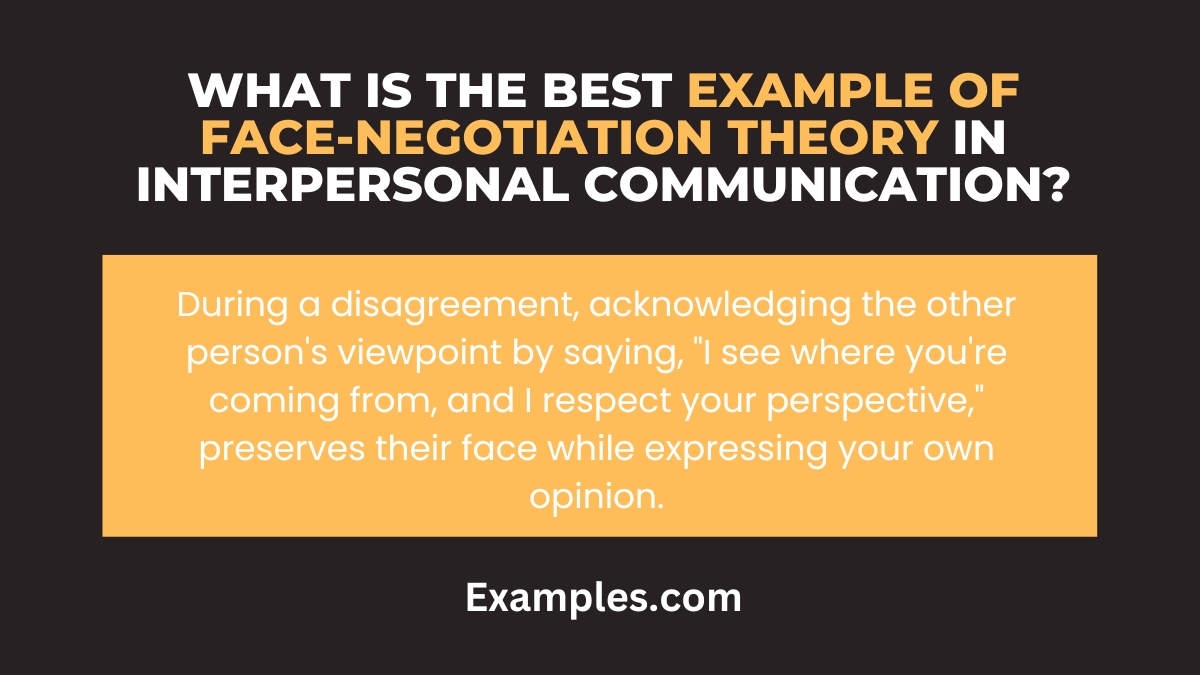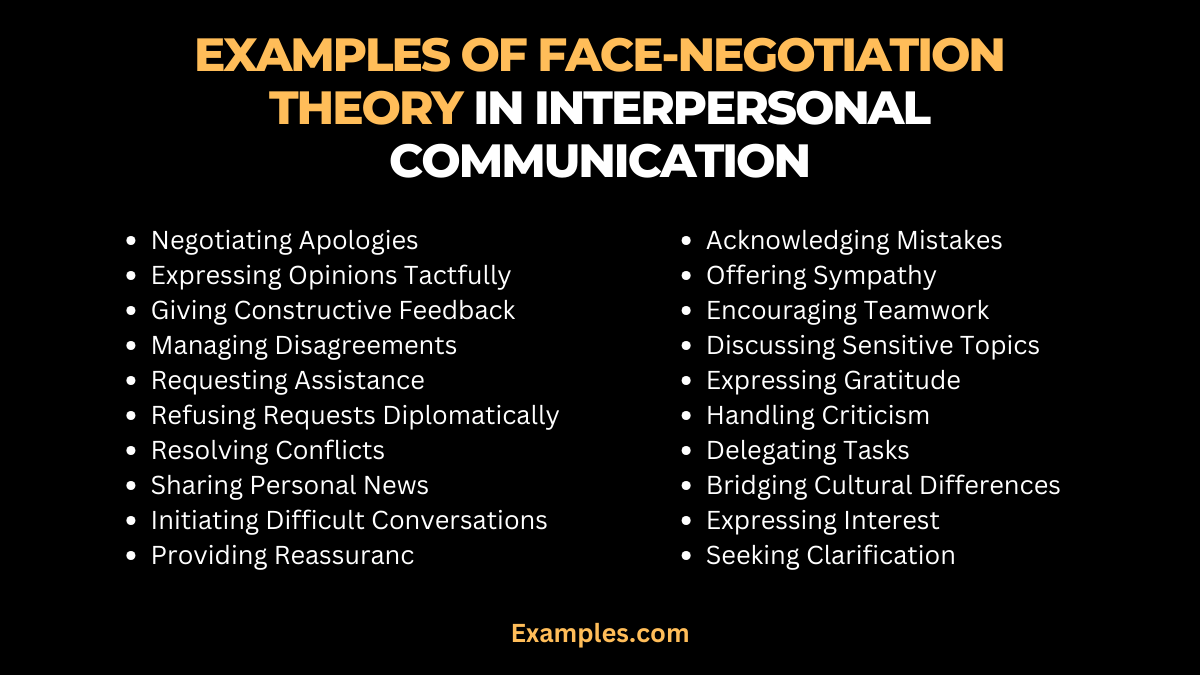Face-Negotiation Theory in Interpersonal Communication
Face-Negotiation Theory is a fascinating aspect of Interpersonal Communication, offering deep insights into how individuals manage conflicts and maintain their self-image in diverse social contexts. This guide illuminates the theory’s nuances, providing practical examples to demonstrate its relevance in everyday interactions. Whether in personal relationships or professional settings, understanding this theory equips you with tools to navigate complex communication landscapes more effectively.
What is Face-Negotiation Theory in Interpersonal Communication?

Face-Negotiation Theory, a critical component of Interpersonal Communication, revolves around how people from different cultures manage conflict and communicate to maintain their self-image, or ‘face’. Originating from sociolinguistic studies, this theory explains the strategies individuals use to avoid conflict and preserve dignity in various social and cultural contexts. Its understanding is vital in a globalized world, enhancing cross-cultural communication and empathy.
History
Who Created: Stella Ting-Toomey
Date: 1985
Stella Ting-Toomey’s Face-Negotiation Theory is central in understanding how cultural differences impact interpersonal interactions, particularly in contexts like interpersonal conflict communication. This theory suggests that individuals manage conflict by negotiating their face, or self-image. Ting-Toomey’s work highlights how people from different cultures have varying approaches to conflict resolution, influenced by their individualistic or collectivistic tendencies.
What is the Best Example of Face-Negotiation Theory in Interpersonal Communication?

A prime example of Face-Negotiation Theory in action is observed in multicultural workplaces. Here, diverse communication styles and conflict resolution strategies come into play, reflecting different cultural values and norms. For instance, in some cultures, direct confrontation might be avoided to maintain harmony, while in others, open discussion is encouraged to resolve issues. Understanding these nuances is crucial for effective Interpersonal Communication, especially in global teams where cultural sensitivity and adaptability are key to fostering a positive and productive work environment.
20 Examples of Face-Negotiation Theory in Interpersonal Communication

Explore 20 insightful examples of Face-Negotiation Theory in Interpersonal Communication. This comprehensive list delves into various scenarios, illustrating how individuals manage their self-image in diverse interactions. From workplace dialogues to personal conversations, these examples provide valuable insights into effectively navigating communication while maintaining personal dignity and social harmony. Perfect for educators, students, and professionals seeking to enhance their communication skills.
- Negotiating Apologies: Here, the speaker is acknowledging potential hurt caused while inviting open dialogue, balancing face-saving with empathy.
Example: “I’m sorry if my words hurt you. Let’s talk about it.” - Expressing Opinions Tactfully: The speaker respectfully presents their view, promoting a constructive exchange without offending the other person.
Example: “I see your point, but have you considered this perspective?” - Giving Constructive Feedback: Positive reinforcement coupled with gentle criticism demonstrates respect for the receiver’s feelings and efforts.
Example: “Your presentation had great ideas, though some parts could be clearer.” - Managing Disagreements: This approach acknowledges differences while focusing on collaboration, maintaining both parties’ dignity.
Example: “I understand we disagree, but let’s find common ground.” - Requesting Assistance: By valuing the other’s skills, the speaker effectively requests help without diminishing their own competence.
Example: “Could you help me with this task? Your expertise would be valuable.” - Refusing Requests Diplomatically: The speaker declines while explaining their situation, ensuring the refusal is not taken personally.
Example: “I wish I could help, but I’m currently overwhelmed with my own work.” - Resolving Conflicts: This shows a commitment to mutual respect and problem-solving, essential in conflict resolution.
Example: “Let’s work together to find a solution that suits us both.” - Sharing Personal News: The speaker cautiously introduces personal information, considering the listener’s interest and reaction.
Example: “I wanted to share some exciting personal news with you.” - Initiating Difficult Conversations: Acknowledging discomfort paves the way for a sensitive yet necessary conversation.
Example: “This is a bit uncomfortable to discuss, but it’s important we address it.” - Providing Reassurance: This reassures the recipient, boosting morale while acknowledging their efforts.
Example: “Your efforts are truly appreciated, even if the results aren’t immediate.” - Acknowledging Mistakes: Owning up to errors shows responsibility and a commitment to improvement.
Example: “I realize I made a mistake there, and I’m working on correcting it.” - Offering Sympathy: Expressing sympathy while offering support upholds the grieving person’s dignity.
Example: “I’m sorry for your loss. I’m here if you need to talk.” - Encouraging Teamwork: Valuing each member’s contribution fosters a collaborative environment.
Example: “Your input is crucial for our team’s success.” - Discussing Sensitive Topics: Recognizing the topic’s sensitivity prepares both parties for a careful conversation.
Example: “I know this topic is sensitive, but it’s important for us to discuss openly.” - Expressing Gratitude: Genuine appreciation strengthens relationships and acknowledges others’ efforts.
Example: “Thank you so much for your help; it really made a difference.” - Handling Criticism: Accepting criticism graciously shows openness to growth and respect for the critic’s perspective.
Example: “I appreciate your feedback. I’ll consider it for future improvements.” - Delegating Tasks: Delegation with trust enhances the recipient’s confidence and autonomy.
Example: “I trust your judgment on this; could you take the lead?” - Bridging Cultural Differences: Showing interest in diverse viewpoints fosters mutual respect and understanding.
Example: “I’d love to understand more about your cultural perspective on this.” - Expressing Interest: Demonstrating genuine interest encourages open sharing and connection.
Example: “That sounds interesting. Could you tell me more?” - Seeking Clarification: Asking for clarification signifies a desire for comprehensive understanding, respecting the speaker’s views.
Example: “Could you elaborate on that point? I want to fully understand your perspective.”
What are the Faces of Face-Negotiation Theory in Interpersonal Communication
Face-Negotiation Theory, primarily developed by Stella Ting-Toomey, is a fundamental concept in Interpersonal Communication. It explores how individuals from different cultures manage conflicts and communicate. This theory has several key facets:
- Self-Identity: At its core, Face-Negotiation Theory revolves around the concept of ‘face’, which relates to one’s self-esteem and identity. It’s about how individuals desire to be perceived and respected by others.
- Cultural Variability: This theory emphasizes that cultural backgrounds significantly influence how individuals negotiate their ‘face’ in social interactions. For instance, in collectivistic cultures, maintaining group harmony might be prioritized, whereas in individualistic cultures, self-expression and personal achievements are often more valued.
- Conflict Management Styles: The theory outlines various conflict management styles, such as avoiding, compromising, and dominating. These styles are often chosen based on how individuals wish to maintain their ‘face’ in different social contexts.
- Individualistic vs. Collectivistic Approaches: The theory differentiates between individualistic and collectivistic cultures in handling interpersonal communication. It suggests that in collectivistic cultures, people tend to use more integrating or obliging styles, while in individualistic cultures, dominating or avoiding styles may be more common.
Face-Negotiation Theory in Interpersonal Communication in Workplace
In the workplace, Face-Negotiation Theory plays a critical role in shaping interpersonal dynamics. Here’s how:
- Conflict Resolution: Understanding this theory helps in recognizing how different employees might approach conflicts based on their cultural backgrounds, leading to more effective conflict resolution strategies.
- Team Dynamics: By acknowledging different ‘face’ needs, managers and team members can foster a more inclusive and understanding work environment, enhancing team collaboration and productivity.
- Communication Strategies: Applying the principles of Face-Negotiation Theory can aid in developing communication strategies that respect individual ‘face’ needs, leading to more effective and harmonious workplace interactions.
- Cultural Sensitivity Training: Incorporating this theory into cultural sensitivity training can help employees understand and appreciate diverse communication styles and conflict management approaches.
What are the Advantages of Face-Negotiation Theory in Interpersonal Communication?
The Face-Negotiation Theory offers several advantages in the realm of interpersonal communication:
- Enhanced Cultural Awareness: This theory provides insights into how cultural differences affect communication, leading to greater cultural awareness and sensitivity.
- Improved Conflict Management: By understanding different ‘face’ needs, individuals can navigate conflicts more effectively, choosing strategies that are respectful of cultural differences.
- Fosters Empathy: Recognizing the role of ‘face’ in communication encourages empathy and understanding, as individuals learn to appreciate different perspectives and communication needs.
- Adaptability in Communication: The theory equips individuals with the knowledge to adapt their communication styles to suit diverse cultural contexts, enhancing their interpersonal effectiveness.
- Promotes Inclusivity: By acknowledging the importance of ‘face’ in different cultures, this theory promotes inclusivity and respect in various interpersonal settings, from personal relationships to professional environments.
Face-Negotiation Theory highlights the cultural nuances in managing self-image during conflicts. It’s essential to understand and respect different face-saving strategies. Improve your interpersonal communication by being culturally sensitive and responsive to others’ face needs. This awareness leads to more effective conflict resolution and stronger, more respectful relationships in diverse cultural contexts.



